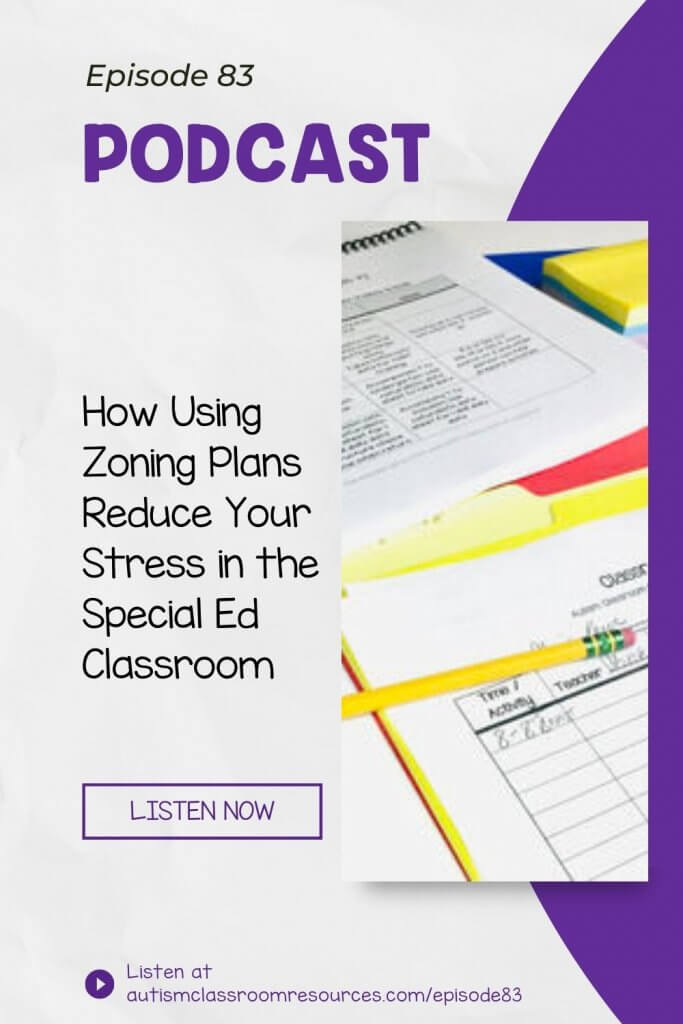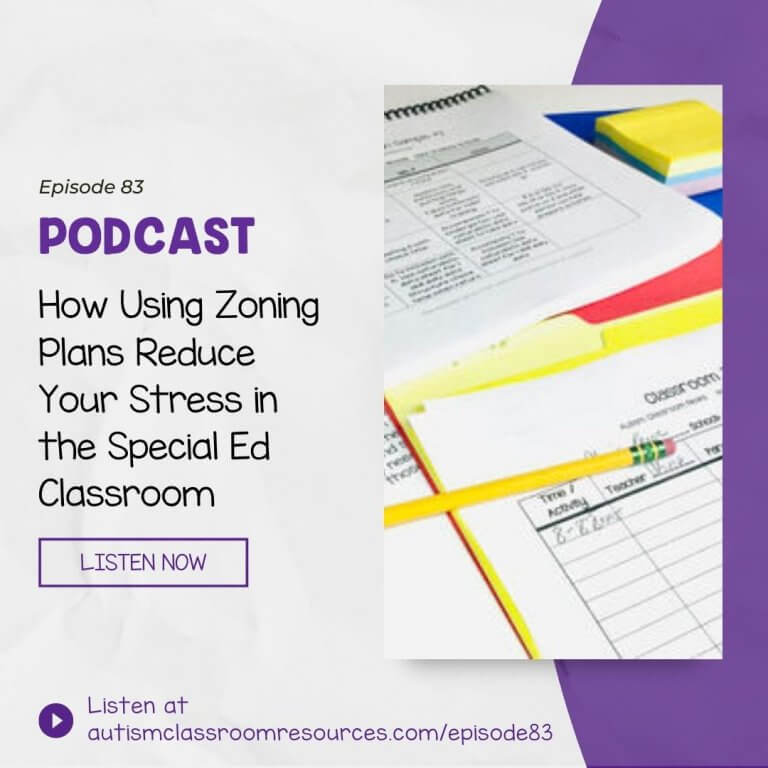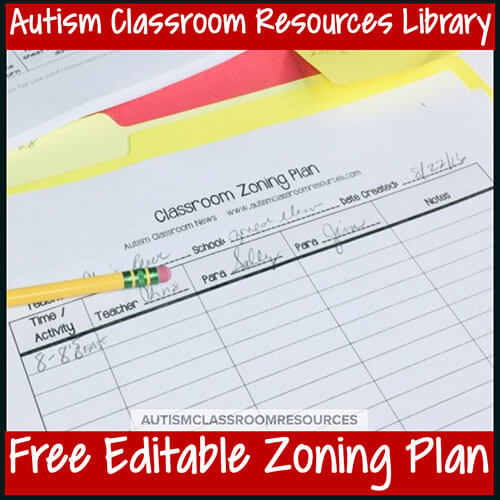Welcome to the Autism Classroom Resources Podcast, the podcast for special educators who are looking for personal and professional development.
I’m your host, Dr. Christine Reeve. For more than 20 years, I’ve worn lots of hats in special education but my real love is helping special educators like you. This podcast will give you tips and ways to implement research-based practices in a practical way in your classroom to make your job easier and more effective.
Welcome back to the Autism Classroom Resources Podcast, I’m Christine Reeve and I’m your host. I am so glad you are joining us as we move through our series on putting systems in place in your classroom to set it up to make your classroom design work for you. We started out talking about IEPs and making sure that you have the needs of the individual students solidified and clear. Then I’ve talked about systems to put in place in your classroom to help the classroom run itself based on the CORE model. If you missed those episodes, go back to autismclassroomresources.com/episode80 to start with the Teaching Implementation Plan. I started with the TIP to plan out how to implement the IEPs of the students and communicate it to the staff. Then that takes you to the classroom schedule that I talked about in Episode 81. In our last episode, I talked about designing the physical space.
Overall, the CORE model sets it up, so that we’re building the center of the classroom to support instruction because the day-to-day running of the classroom works on its own. To do that, we need systems. Systems get set up, so that the people in the classroom know what needs to be done and can do it on their own without the teacher having to pull attention from the students to direct something. That’s what we’re going to talk about today. I talked about zoning plans in Episode 45. In that episode, I talked all about why they are called zoning plans, as well as why you need them. Zoning plans are essentially staff schedules but they are so much more. You can grab that episode at autismclassroomresources.com/episode45.
Today, I want to focus on how a zoning plan can help save you time, energy, and basically make your life a whole lot easier. It takes some time up front like all of these systems, because you know how much I like to say, well begun is half done. Thanks, Mary Poppins. Because it’s true, if you put this time in up front, it won’t be perfect when the year starts, it will need to be tweaked but your classroom will run more smoothly and your life will be so much easier. Now, I’ve got a free download for you in this episode and links to examples of lots of zoning plans so that you can see what they look like and they’re all in the post that goes with this episode at autismclassroomresources.com/episode83. I’ll also include a link there to my Building Classroom Teams Toolkit that has videos and forms for creating a classroom zoning plan, and developing classroom teams to work effectively with the staff in the room from my store.
If you’re looking for ongoing support and a more in-depth dive, and some community support for everything in your special ed classroom, come and try out the Special Educator Academy. We have a whole course on designing and choreographing your classroom, and we are in the midst of a study group now on Sunday nights in the membership to go through the course together. It’s a chance to share schedules, floor plans, zoning plans, and more even if you can’t be there live on Sunday nights and get some feedback from me, and from the community of teachers like you. Come join with a seven-day free trial and see if it’s for you. Even if you started the year and missed the study group, the course is available whenever it works for you to go at your own pace in small segments. We have tons of resources in the academy beyond just this course, so check it out at specialeducatoracademy.com. Now, that’s enough. Let’s get started.
I am guessing that many, if not most of you who are teachers, did not have tons of coursework in managing staff, yet if you walked into almost any special education job, you immediately were put in a position of having to direct staff even when you weren’t really their supervisor. It’s not an easy position to be in even if you have training in it for a ton of different reasons. I’ve talked about how to build teamwork within your classroom in Episodes 1 to 5 of the podcast, so I’ve got tips about how to build rapport with your staff and build the culture of your classroom in those episodes. Today, I’m going to focus on the nuts and bolts of running the classroom.
The zoning plan is essentially a staff schedule on steroids. I’ve tried over the years to just call it a staff schedule but it really is so much more. The zoning plan is designed to make sure that you have all the information integrated to allow staff to work as independently as possible. That frees you up to focus on your work with the students. Essentially, you’re outlining all the tasks that have to be done by all the staff and you’re signing them out throughout the day on the zoning plan. Since I’ve talked more about it in Episode 45, I won’t take the time to go into a whole bunch of details about it. Instead, today I want to focus about why it’s worth taking the time to do this. I recognize we have enough paperwork in our lives but the zoning plan can save your sanity and I am so not exaggerating. Let me tell you three reasons why.
Number one, I’ve already alluded to this one, but essentially, a zoning plan is a key element to automating your classroom. In order to have high levels of engagement, which is part of the CORE program, which we know from research and from the Center for Exceptional Children’s High-Leverage Practices are essential to good instruction, we need to spend all the time that we can focused on the students and you can’t do that if you’re focused on directing the staff. If you’re working with students and every few minutes you have to answer a question from the staff, tell a staff member where to go, tell them what you need them to do, or redirect them—you get the idea—that’s a problem. That’s a problem that takes your attention away from working with your students and that detracts from your ability to keep them engaged.
A second way that the zoning plan can make your life so much easier is by significantly lowering the interpersonal drama in your classroom. Let’s face it. Classrooms in education, in general, can be dramatic enough without adding adult drama to the mix. The great thing about zoning plans is that you develop them collaboratively with the team. You get your team’s input and you write it down, and it clarifies for staff what needs to be done. That means it eliminates the guesswork of them trying to figure out what you want them to do because they cannot read your mind. It also reduces the chance that in trying to read your mind, they end up driving you nuts. Like when I watched four staff members clean a table after snack while the teacher was left with 15 preschoolers trying to run circle time. The staff knew the table needed to be cleaned up for a later activity but it really doesn’t take all four of them to do that. The teacher was so swamped. She didn’t have a lot of focus left to redirect the staff. A zoning plan solves that problem.
A zoning plan also solves the issues that might become administrative issues in the future. If there is disagreement about whether a staff member knew what to do, there’s a written document about it and because you’ve worked together on it, hopefully, you’ve avoided some of those issues and worked through some of them more effectively.
Three, finally, another way that the zoning plan can save your sanity is that they can reduce decision fatigue. Decision fatigue is real. I’ve talked about it in previous episodes that I’ll link to in the blog post. But having to switch your focus back and forth constantly in the classroom to directing the staff, to working with students, and making decisions about each one is part of that. Having to make decisions on the fly about what your staff should be doing when you’re trying to be highly focused on your students and you have to make decisions about them, all of that takes a toll on your energy reserves and it’s exhausting.
The more that you can automate and have the staff working independently on what needs to be done, the less things you have to switch your attention between. The less attention shifting there is for you, the less last minute decisions or decisions coming out of the blue there are for you and the less stress there is for you. It makes your day so much better. Let’s face it, our days are stressful enough. Let’s not find ways to make them harder.
Those are three ways that a zoning plan can save your sanity in the classroom by automating your classroom, keeping your attention on your students, reducing your decision fatigue, and toning down the drama. They are also good for your students because they increase the engagement with students in instruction and there’s research to support that. That also reduces challenging behavior. The more your students are engaged, the less challenging behavior you have, and that’s good for everybody.
Now, I’ve got a free zoning plan template and lots of links to zoning plan examples in the post for this episode at autismclassroomresources.com/episode83. Hop over and grab those. Don’t forget that we have a whole course on setting up these classroom systems that can make your life so much easier in the Special Educator Academy. Come give the seven day free trial a whirl and see if it’s a good match for you at specialeducatoracademy.com.
If you’re a special educator, I would love to hear your questions about setting up the classroom too. If you’re not part of the Special Educator Academy, hop over to our free Facebook group and share them at specialeducatorsconnection.com. Thank you so much for listening. I hope you’ll be coming back next week when I will be talking about which are the visuals that you absolutely have to have so that you can be prepping by the pool to start the year. Until then, I’ll be hanging by the pool with some laminate to cut. See you then.









